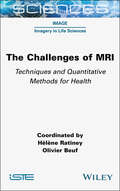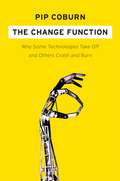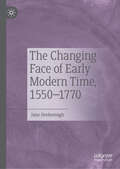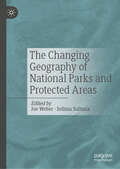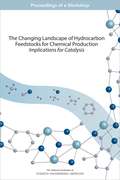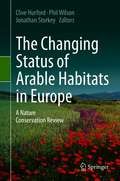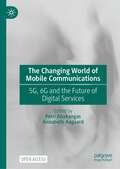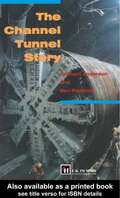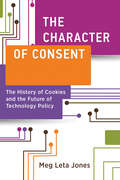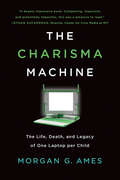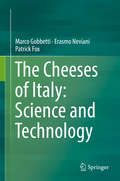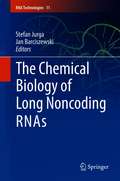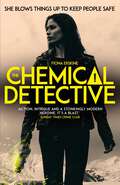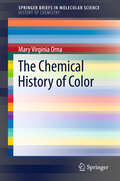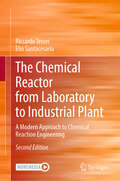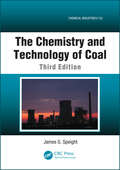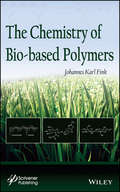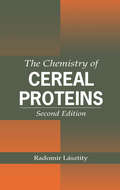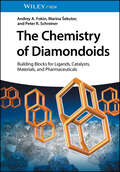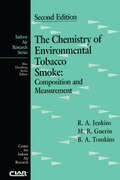- Table View
- List View
The Challenges of MRI: Techniques and Quantitative Methods for Health
by Olivier Beuf Hélène RatineyAfter a review of the essential concepts of magnetic resonance imaging (MRI), The Challenges of MRI presents the recent techniques and methods of MRI and resulting medical applications. These techniques provide access to information that goes well beyond anatomy, with functional, hemodynamic, structural, biomechanical and biochemical information. MRI allows us to probe living organisms in a multitude of ways, guaranteeing the potential for continuous development involving several disciplines: physics, electronics, life sciences, signal processing and medicine. This collective work is made up of chapters written and designed by experts from the French community. They have endeavored to describe the techniques by recalling the underlying physics and detailing the modeling, methods and strategies for acquiring or extracting information. This book is aimed at master’s students and PhD students, as well as lecturers and researchers in medical imaging and radiology.
The Change Function
by Pip CoburnThe ultimate guide to predicting winners and losers in high technology Pip Coburn became famous for writing some of the liveliest reports on Wall Street. He quoted everyone from Machiavelli to HAL, Anaïs Nin to Yoda, Einstein to Gandhi. But along with the quirky writing, he consistently delivered sharp insights into technology trends and helped investors pick stocks with long-term potential. After years of studying countless winners and losers, Coburn has come up with a simple idea that explains why some technologies become huge hits (iPods, DVD players, Netflix), but others never reach more than a tiny audience (Segways, video phones, tablet PCs). He says that people are only willing to change when the pain of their current situation outweighs the perceived pain of trying something new. In other words, technology demands a change in habits, and that's the leading cause of failure for countless cool inventions. Too many tech companies believe in "build it and they will come"-- build something better and people will beat a path to your door. But, as Coburn shows, most potential users are afraid of new technologies, and they need a really great reason to change. The Change Function is an irreverent look at how this pattern plays out in countless sectors, from computers to cell phones to digital TV recorders. It will be an invaluable book for people who create and invest in new technologies.
The Changing Face of Early Modern Time, 1550–1770
by Jane DesboroughThis book provides a reinterpretation of early modern clock and watch dials on the basis of use. Between 1550 and the emergence of a standard format in 1770, dials represented combinations of calendrical, lunar and astronomical information using multiple concentric rings, subsidiary dials and apertures. Change was gradual, but significant. Over the course of eight chapters and with reference to thirty-five exceptional images, this book unlocks the meaning embedded within these early combinations. The true significance of dial change can only be fully understood by comparing dials with printed paper sources such as almanacs, diagrams and craft pamphlets. Clock and watch makers drew on traditional communication methods, utilised different formats to generate trust in their work, and tried to be help users in different contexts. The calendar, lunar and astronomical functions were useful as a memory prompt for astrology up until the mid-late seventeenth century. After the decline of this practice, the three functions continued to be useful for other purposes, but eventually declined.
The Changing Geography of National Parks and Protected Areas
by Joe Weber Selima SultanaThis book contains recent geographic work examining the changing geography of protected areas in the U.S. and Europe. These places can be national parks, forests, or other places that are being protected for their significant aesthetic, historical, or environmental values by governments and communities. These places can be studied with reference to their physical environments, the management of their plant and animal life, which places are to be protected, who visits these places (and who does not, and why not), and how we think of these places. This work includes examinations of many parks and issues that affect them, such as land degradation, the social and political geography involved in creating new national park units, visitation by underserved segments of the population, and the changing names of protected areas. It makes use of work using methods and data as diverse as remote sensing, nineteenth survey plats and GIS, and online visitor surveys.
The Changing Landscape of Hydrocarbon Feedstocks for Chemical Production: Proceedings of a Workshop
by Engineering Medicine National Academies of SciencesA decade ago, the U.S. chemical industry was in decline. Of the more than 40 chemical manufacturing plants being built worldwide in the mid-2000s with more than 1$ billion in capitalization, none were under construction in the United States. Today, as a result of abundant domestic supplies of affordable natural gas and natural gas liquids resulting from the dramatic rise in shale gas production, the U.S. chemical industry has gone from the world’s highest-cost producer in 2005 to among the lowest-cost producers today. The low cost and increased supply of natural gas and natural gas liquids provides an opportunity to discover and develop new catalysts and processes to enable the direct conversion of natural gas and natural gas liquids into value-added chemicals with a lower carbon footprint. The economic implications of developing advanced technologies to utilize and process natural gas and natural gas liquids for chemical production could be significant, as commodity, intermediate, and fine chemicals represent a higher-economic-value use of shale gas compared with its use as a fuel. To better understand the opportunities for catalysis research in an era of shifting feedstocks for chemical production and to identify the gaps in the current research portfolio, the National Academies of Sciences, Engineering, and Medicine conducted an interactive, multidisciplinary workshop in March 2016. The goal of this workshop was to identify advances in catalysis that can enable the United States to fully realize the potential of the shale gas revolution for the U.S. chemical industry and, as a result, to help target the efforts of U.S. researchers and funding agencies on those areas of science and technology development that are most critical to achieving these advances. This publication summarizes the presentations and discussions from the workshop.
The Changing Status of Arable Habitats in Europe: A Nature Conservation Review
by Clive Hurford Phil Wilson Jonathan StorkeyThis edited volume documents the current nature conservation status of arable habitats in Europe. Arable farming systems have evolved in the European landscape over more than ten thousand years and now occupy nearly 30% of the European land area. They support species that have life cycles closely synchronised with traditional cereal growing, many of which have experienced massive declines throughout Europe. For example, in Britain, of the 100 plant species exhibiting the greatest declines in the latter half of the 20th century, 47 were typical of arable land. Despite this the habitat and many of the species associated with it remains unprotected across much of Europe. The 22 chapters cover a range of topics, including: · Regional accounts describing the impact of changing agricultural practices on the arable flora;· The results of research and surveillance projects on the soil organisms, bryophyte flora, invertebrate fauna and pollinators of arable habitats;· The potential for designing multifunctional and resilient agricultural landscapes; The use of ex situ conservation to aid the reintroduction of rare arable plants;· Case studies illustrating how changing agricultural practices have impacted on bird populations in Europe; · The roles of remote sensing in monitoring agricultural systems; · How agri-environment schemes can help restore the biodiversity in arable habitats; and · A look forward at ways to help ensure the future security of the species associated with arable habitats. It is clear that the biodiversity of arable land throughout Europe has undergone major changes, particularly during the second half of the 20th century, and that these changes are continuing into the 21st century. We need to develop a deeper appreciation of farmland wildlife and its integration into farming systems to ensure its future security in a world where value is increasingly expressed in terms of material profit. This book is particularly relevant to practitioners, policy-makers and managers working in the fields of nature conservation, agri-environment schemes and land management, and to researchers working in the fields of conservation biology, terrestrial ecology, nature conservation, applied ecology, biodiversity, agriculture, agricultural ethics and environmental studies.
The Changing World of Mobile Communications: 5G, 6G and the Future of Digital Services
by Annabeth Aagaard Petri AhokangasThis open access book from the world’s first 6G Flagship research program at the University of Oulu, Finland, provides a multi-disciplinary and insightful overview of the subject, with contributions from experts in the field. Today’s fourth generation of mobile connectivity services (4G) are available everywhere, and adoption of fifth generation (5G) networks is well underway. Compared to 4G, 5G has already brought about new business opportunities and enabled seamless virtual and augmented reality services, but also raised serious concerns on data privacy and security and the use of artificial intelligence. The sixth generation (6G) networks are already in R&D phase aiming at deployment in 2030. We need to understand today what 5G evolution and 6G may bring for the future of service delivery and how they will influence us. The contributions answer what 5G, its evolution, and 6G will be about; what kind of impacts 5G and 6G will have on future digital services, businesses, and society; how we could benefit from 5G and 6G innovations; and how 5G and 6G should be regulated in the future. Future 5G evolution and 6G are not only about moving toward faster, better, and more secure networks providing the basis for innovative digital services, they are also going to bring about a huge digital disruption that will affect all levels of society. This book will be of great interest to academics and students of management, telecommunications and digital innovation, as well practitioners and policymakers looking to the future of business.
The Channel Tunnel Story
by Graham Anderson Ben RoskrowThe Channel Tunnel is a huge construction project, employing over 14,000 people at peak, and costing over 11 billion of private money. It has succeeded in spite of great financial, political and techncial difficulties, and a fundamentally flawed contract. This book tells the story of the project, based on the coverage in Construction News and with
The Chaos Agent: The superb, action-packed new Gray Man thriller (Gray Man #13)
by Mark GreaneyArtificial intelligence leads to shockingly real devastation in this new novel in the #1 New York Times bestselling Gray Man series.A car accident in Japan. A drowning in Seoul. A home invasion in Boston. Someone is killing the world's leading experts on robotics and artificial intelligence. Is it a tech company trying to eliminate the competition or something even more sinister? After all, AI may be the deadliest battlefield gamechanger since the creation of gunpowder. Meanwhile, the quest for a quiet life has led the Gray Man to Central America, where he and his lover Zoya Zakharova have assumed new identities. Eventually, they're tracked down and offered a job by an old acquaintance of Zoya's: to extract a Russian scientist who is on the kill list. They reject it, but just being seen with him is enough to put assassins on their trail. Now, they're back on the run, but no matter which way they turn, whoever's tracking them is always one step ahead. Since flight's no longer possible, fight is the only option left, and no one fights dirtier than the Gray Man.
The Character of Consent: The History of Cookies and the Future of Technology Policy (Information Policy)
by Meg Leta JonesThe rich, untold origin story of the ubiquitous web cookie—what&’s wrong with it, why it&’s being retired, and how we can do better.Consent pop-ups continually ask us to download cookies to our computers, but is this all-too-familiar form of privacy protection effective? No, Meg Leta Jones explains in The Character of Consent, rather than promote functionality, privacy, and decentralization, cookie technology has instead made the internet invasive, limited, and clunky. Good thing, then, that the cookie is set for retirement in 2024. In this eye-opening book, Jones tells the little-known story of this broken consent arrangement, tracing it back to the major transnational conflicts around digital consent over the last twenty-five years. What she finds is that the policy controversy is not, in fact, an information crisis—it&’s an identity crisis.Instead of asking how people consent, Jones asks who exactly is consenting and to what. Packed into those cookie pop-ups, she explains, are three distinct areas of law with three different characters who can consent. Within (mainly European) data protection law, the data subject consents. Within communication privacy law, the user consents. And within consumer protection law, the privacy consumer consents. These areas of law have very different histories, motivations, institutional structures, expertise, and strategies, so consent—and the characters who can consent—plays a unique role in those areas of law. The Character of Consent gives each computer character its due, taking us back to their origin stories within the legal history of computing. By doing so, Jones provides alternative ways of understanding the core issues within the consent dilemma. More importantly, she offers bold new approaches to creating and adopting better tech policies in the future.
The Charisma Machine: The Life, Death, and Legacy of One Laptop per Child (Infrastructures)
by Morgan G. AmesA fascinating examination of technological utopianism and its complicated consequences.In The Charisma Machine, Morgan Ames chronicles the life and legacy of the One Laptop per Child project and explains why—despite its failures—the same utopian visions that inspired OLPC still motivate other projects trying to use technology to “disrupt” education and development. Announced in 2005 by MIT Media Lab cofounder Nicholas Negroponte, One Laptop per Child promised to transform the lives of children across the Global South with a small, sturdy, and cheap laptop computer, powered by a hand crank. In reality, the project fell short in many ways—starting with the hand crank, which never materialized. Yet the project remained charismatic to many who were captivated by its claims of access to educational opportunities previously out of reach. Behind its promises, OLPC, like many technology projects that make similarly grand claims, had a fundamentally flawed vision of who the computer was made for and what role technology should play in learning.Drawing on fifty years of history and a seven-month study of a model OLPC project in Paraguay, Ames reveals that the laptops were not only frustrating to use, easy to break, and hard to repair, they were designed for “technically precocious boys”—idealized younger versions of the developers themselves—rather than the children who were actually using them. The Charisma Machine offers a cautionary tale about the allure of technology hype and the problems that result when utopian dreams drive technology development.
The Cheeses of Italy: Science And Technology
by Marco Gobbetti Erasmo Neviani Patrick FoxThe book will contain a detailed description on the historical aspects of cheese manufacture, a culmination of historical information on the most traditional and worldwide popular Italian cheese varieties. An overview on cheese production is also included, covering the main general aspects. An overall classification of Italian cheeses will follow, aiming to categorize all the cheese varieties that have a tradition and/or an economic importance. Based on a large literature review, the core of the book will include descriptions cheese making traits which are unique to Italian cheese biotechnology. In particular, the milk chemical composition, the use whey or milk natural starters, some technology options (e.g., curd cooking), the microbiota composition and metabolism during curd ripening, especially for cheese made with raw milk, and the main relevant biochemical events, which occur during the very long-time ripening, will be described. The last part of the book will consider a detailed description of the biotechnology for the manufacture of the most traditional and popular cheeses worldwide.
The Chemical Biology of Long Noncoding RNAs (RNA Technologies #11)
by Jan Barciszewski Stefan JurgaThis book offers a comprehensive and detailed overview of various aspects of long non-coding RNAs. It discusses their emerging significance in molecular medicine, ranging from human cancers to cardiovascular and metabolic diseases. Transcriptomic studies have demonstrated that the majority of genomes found in complex organisms are expressed in highly dynamic and cell-specific patterns, producing huge numbers of intergenic, antisense and intronic long non-protein-coding RNAs (lncRNAs). Thousands of lncRNAs have been identified, and unlike mRNA, they have no protein-coding capacity. A large repertoire of ncRNAs, actively transcribed from the mammalian genome, control diverse cellular processes, both in terms of development and diseases, through a variety of gene regulatory mechanisms. IncRNAs have emerged as a new paradigm in epigenetic regulation of the genome. Given its scope, the book will be of particular interest to molecular, chemical, cell and developmental biologists, as well as specialists in translational medicine involved in disease-oriented research. It also offers a valuable resource for in silico experts seeking a deeper understanding of lncRNA expression and function through computational analysis of the NGS data.
The Chemical Detective
by Fiona ErskineFor fans of Killing Eve and Orphan X comes the electrifying Chemical Detective Dr Jaq Silver. Skier, scientist, international jet-setter, explosives expert. She blows things up to keep people safe. Working on avalanche control in Slovenia, Jaq stumbles across a problem with a consignment of explosives. After raising a complaint with the supplier, a multinational chemical company, her evidence disappears. Jaq is warned, threatened and suspended. When she takes her complaint further, she narrowly escapes death only to be framed for murder. Escaping from police custody, she sets out to find the key to the mystery. Racing between the snowy slopes of Slovenia and the ghostly ruins of Chernobyl, can she uncover the truth before her time runs out?
The Chemical History of Color
by Mary Virginia OrnaIn this brief, Mary Virginia Orna details the history of color from the chemical point of view. Beginning with the first recorded uses of color and ending in the development of our modern chemical industry, this rich, yet concise exposition shows us how color pervades every aspect of our lives. Our consciousness, our perceptions, our useful appliances and tools, our playthings, our entertainment, our health, and our diagnostic apparatus - all involve color and are based in no small part on chemistry.
The Chemical Reaction
by Fiona ErskineAs Jaq is pulled further into a murky underworld of deceit and corruption, things take an explosive turn… After escaping almost certain death amidst the ruins of Chernobyl, Jaq finds herself in even hotter water. Deep in debt, she decides to take on a risky contract in China. But when her old student and the chemical factory she was meant to be investigating both mysteriously disappear, she realises nothing is as it seems. From fraudulent art auctions in London to a troupe of male strippers in Shanghai, the mystery of the vanishing factory begins to look ever more complicated as the days pass. Can Jaq work out what happened – and whether it has anything to do with her nemesis Frank Good – before time runs out?
The Chemical Reactor from Laboratory to Industrial Plant: A Modern Approach to Chemical Reaction Engineering
by Elio Santacesaria Riccardo TesserThis second edition presents updated key concepts and exercises in chemical reaction engineering. While retaining the foundational structure of the first edition, this graduate textbook offers 2 new chapters devoted to polymerization reactions and reactors, and to bioreactors, and provides a complete and more suitable overview of the field for students and researchers of Chemical Reaction Engineering Sciences. The Preface of this edition has been rewritten to justify the changes conducted since the first edition. The subsequent chapters introduce students to the concepts behind the successful design and operation of chemical reactors, with an emphasis on qualitative arguments, simple design methods, graphical procedures, and frequent comparison of capabilities of the major reactor types. These chapters were updated and/or enriched with new exercises, and particular attention was given to the following topics: Chapter 2: Expanded Vapour-Liquid Equilibria (VLE) in multi-component systems with new exercises, including flash separation with reaction. Chapter 3: Deepened surface acidity distribution of heterogeneous catalysts with a new exercise. Chapters 4 & 5: Enlarged exercises with further calculations, plots, and new solved exercises. Chapter 6: Enriched with a new exercise on effectiveness factor calculation, covering mass, heat, and momentum transport laws and their relationship with chemical kinetics. Chapter 7: Added exercise to determine concentration profiles in the liquid film for gas-liquid reactions at different reaction rates. Chapter 8: New chapter on polymers and polymerization reactors, detailing mechanisms and kinetics with solved examples and exercises for various polymerization types. Chapter 9: New chapter on Bioreactors, covering the evolution of kinetic models for fermentation processes, including metabolic and cybernetic models applied to baker yeast and bioethanol production, with examples and solved exercises. The authors conducted a comprehensive revision of all the MATLAB code exercises to ensure they aligned with current learning objectives and described in detail the mathematical strategy adopted, particularly for the more complex problems. With expanded content, practical exercises, and new chapters, this textbook equips students and professionals alike with the knowledge and tools to excel in chemical and industrial engineering.
The Chemistry Knowledge for Firefighters
by Torsten SchmiermundChemical facts taught in firefighting training courses are often "isolated facts." In the book, these facts are integrated into an overall chemical-physical concept. Backgrounds are illuminated, and connections can be recognized. The overall understanding is facilitated, tactical measures for the operation become "logical".This book is a translation of the original German 1st edition Das Chemiewissen für die Feuerwehr by Torsten Schmiermund, published by Springer-Verlag GmbH Germany, part of Springer Nature in 2019. The translation was done with the help of artificial intelligence (machine translation by the service DeepL.com). A subsequent human revision was done primarily in terms of content, so that the book will read stylistically differently from a conventional translation. Springer Nature works continuously to further the development of tools for the production of books and on the related technologies to support the authors.
The Chemistry and Technology of Coal (Chemical Industries)
by James G. SpeightThe demand for coal use (for electricity generation) and coal products, particularly liquid fuels and chemical feedstocks, is increasing throughout the world. Traditional markets such as North America and Europe are experiencing a steady increase in demand whereas emerging Asian markets, such as India and China, are witnessing a rapid surge in dema
The Chemistry of Bio-based Polymers
by Johannes Karl FinkAn exhaustive and timely overview of renewable polymers from a respected chemist and successful author The recent explosion of interdisciplinary research has fragmented the knowledge base surrounding renewable polymers. The Chemistry of Bio-based Polymers brings together, in one volume, the research and work of Professor Johannes Fink, focusing on biopolymers that can be synthesized from renewable polymers. After introducing general aspects of the field, the book’s subsequent chapters examine the chemistry of biodegradable polymeric types sorted by their chemical compounds, including the synthesis of low molecular compounds. Various categories of biopolymers are detailed including vinyl-based polymers, acid and lactone polymers, ester and amide polymers, carbohydrate-related polymers and others. Procedures for the preparation of biopolymers and biodegradable nanocomposites are arranged by chemical methods and in vitro biological methods, with discussion of the issue of “plastics from bacteria.” The factors influencing the degradation and biodegradation of polymers used in food packaging, exposed to various environments, are detailed at length. The book covers the medical applications of bio-based polymers, concentrating on controlled drug delivery, temporary prostheses, and scaffolds for tissue engineering. Professor Fink also addresses renewable resources for fabricating biofuels and argues for localized biorefineries, as biomass feedstocks are more efficiently handled locally. Audience The Chemistry of Bio-based Polymers will be read by chemists, polymer and materials scientists, chemical, bio-based, and biomedical engineers, agricultural and environmental faculty and all those who work in the bioeconomy area. This book will be critical for engineers in a number of industries including food packaging, medical devices, personal care, fuels, auto, and construction.
The Chemistry of Bio-based Polymers
by Johannes Karl FinkThe recent explosion of interdisciplinary research has fragmented the knowledge base surrounding renewable polymers. The Chemistry of Bio-based Polymers 2nd edition brings together, in one volume, the research and work of Professor Johannes Fink, focusing on biopolymers that can be synthesized from renewable polymers. After introducing general aspects of the field, the book’s subsequent chapters examine the chemistry of biodegradable polymeric types sorted by their chemical compounds, including the synthesis of low molecular compounds. Various categories of biopolymers are detailed including vinyl-based polymers, acid and lactone polymers, ester and amide polymers, carbohydrate-related polymers and others. Procedures for the preparation of biopolymers and biodegradable nanocomposites are arranged by chemical methods and in vitro biological methods, with discussion of the issue of “plastics from bacteria.” The factors influencing the degradation and biodegradation of polymers used in food packaging, exposed to various environments, are detailed at length. The book covers the medical applications of bio-based polymers, concentrating on controlled drug delivery, temporary prostheses, and scaffolds for tissue engineering. Professor Fink also addresses renewable resources for fabricating biofuels and argues for localized biorefineries, as biomass feedstocks are more efficiently handled locally.
The Chemistry of Cereal Proteins
by Radomir LasztityIn the past decade, since the first edition was published, the study of cereal protein chemistry has grown and changed. New separation techniques have been introduced while the application of achievements of molecular biology and genetic engineering of proteins has progressed dramatically. This new edition includes these advances and updates the chemistry of cereal proteins for all specialists working in theory and practice of cereal grain production and processing.
The Chemistry of Diamondoids: Building Blocks for Ligands, Catalysts, Pharmaceuticals, and Materials
by Andrey A. Fokin Marina Sekutor Peter R. SchreinerThe Chemistry of Diamondoids Comprehensive resource on an important and fascinating compound class, covering synthesis, properties, functionalization, and applications in organic synthesis, materials science, and more The Chemistry of Diamondoids gives a state-of-the-art overview of all aspects of diamondoid chemistry, covering nomenclature, natural occurrence, chemical and physical properties, along with synthesis and functionalization of diamondoids as well as their applications as molecular building blocks in organic synthesis, polymer and materials science, nanotechnology, and medicinal chemistry. The book concludes with a perspective towards future developments in the field, thereby drawing attention to areas open for discovery. Written by experts in the field, The Chemistry of Diamondoids includes information on: Naturally occurring diamondoids, their formation, and the role they play in the petroleum industry and in geosciences, plus man-made approaches to prepare them on large scale Growing diamond from diamondoids via seeding, preparation and properties of diamondoid oligomers and doped diamondoids C–H-bond functionalization, a precondition for their use in many applications, and fine-tuning of diamondoid properties by precise cage substitution reactions With its all-encompassing approach, The Chemistry of Diamondoids is a valuable guide for newcomers and researchers in organic chemistry and materials science interested in modern synthetic methods and organic functional materials.
The Chemistry of Environmental Tobacco Smoke: Composition and Measurement, Second Edition (Indoor Air Research)
by Roger A. Jenkins Bruce Tomkins Michael R. GuerinConsidered the definitive resource in its field, The Chemistry of Environmental Tobacco Smoke: Composition and Measurement compiles observations on the properties of Environmental Tobacco Smoke (ETS) and on the concentrations of its constituents in indoor air. It focuses on common natural indoor environments and environments associated with chronic exposure. The authors -- all renowned experts -- stress both measurement methods and the competing sources of indoor air contaminants commonly attributed to ETS. For the second edition, each chapter has been updated to reflect new studies and up-to-date information.
The Chemistry of Food
by Jan VelisekA core subject in food Science, food chemistry is the study of the chemical composition, processes and interactions of all biological and non-biological components of foods. This book is an English language translation of the author's Czech-language food chemistry textbook. The first half of the book contains an introductory chapter and six chapters dealing with main macro- and micronutrients, and the essential nutritional factors that determine the nutritional and energy value of food raw materials and foods. It includes chapters devoted to amino acids, peptides and proteins, fats and other lipids, carbohydrates, vitamins, mineral substances and water. The second half of the book deals with compounds responsible for odour, taste and colour that determine the sensory quality of food materials and foods. It further includes chapters devoted to antinutritional, toxic and other biologically active substances, food additives and contaminants. Students, teachers and food technologists will find this book an essential reference on detailed information about the changes and reactions that occur during food processing and storage and possibilities how to manage them. Nutritionists and those who are interested in healthy nutrition will find information about nutrients, novel foods, organic foods, nutraceuticals, dietary supplements, antinutritional factors, food additives and contaminants.
